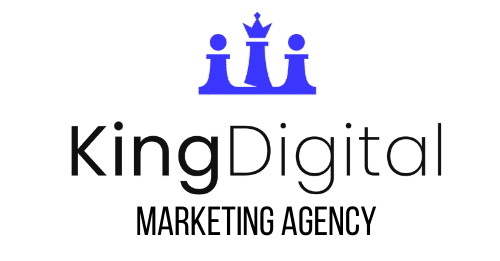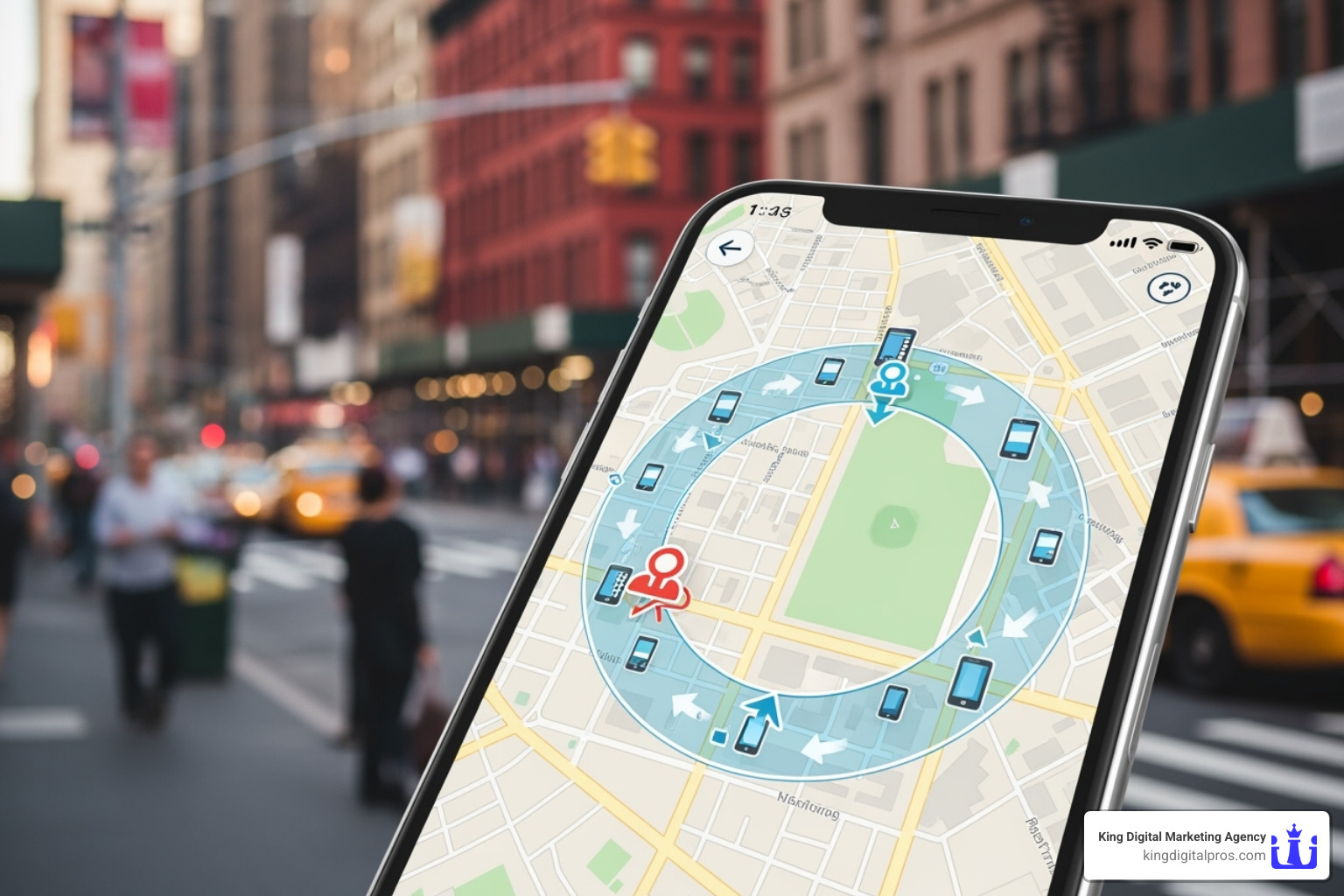What Is Geofencing Marketing and Why Local Businesses Need It
The geofencing marketing meaning is straightforward: it’s a location-based advertising strategy that sends targeted messages to mobile devices when people enter or exit virtual boundaries set around specific areas.
Quick Definition:
- What it is: A virtual fence around a real-world location that triggers an automated action, like an ad or notification.
- How it works: It uses a device’s GPS, Wi-Fi, or cellular data to detect when someone enters a predefined zone.
- Why it matters: It allows you to reach customers at the exact moment they are near your business or a competitor.
This technology transforms how local businesses connect with nearby customers. Instead of broadcasting ads and hoping they reach the right people, geofencing targets shoppers who are already in your neighborhood.
The results are compelling: over 50% of people visit a retailer after receiving a location-specific message, and 3 out of 4 consumers take action after getting a geofenced notification.
For business owners struggling to attract foot traffic, geofencing offers a direct line to potential customers. It’s like having a digital salesperson who knows exactly when someone is nearby.
I’m Bernadette King, and I specialize in helping local businesses find digital marketing strategies that drive real-world results. Understanding the geofencing marketing meaning has been crucial for my clients to compete with larger companies and build stronger local connections.
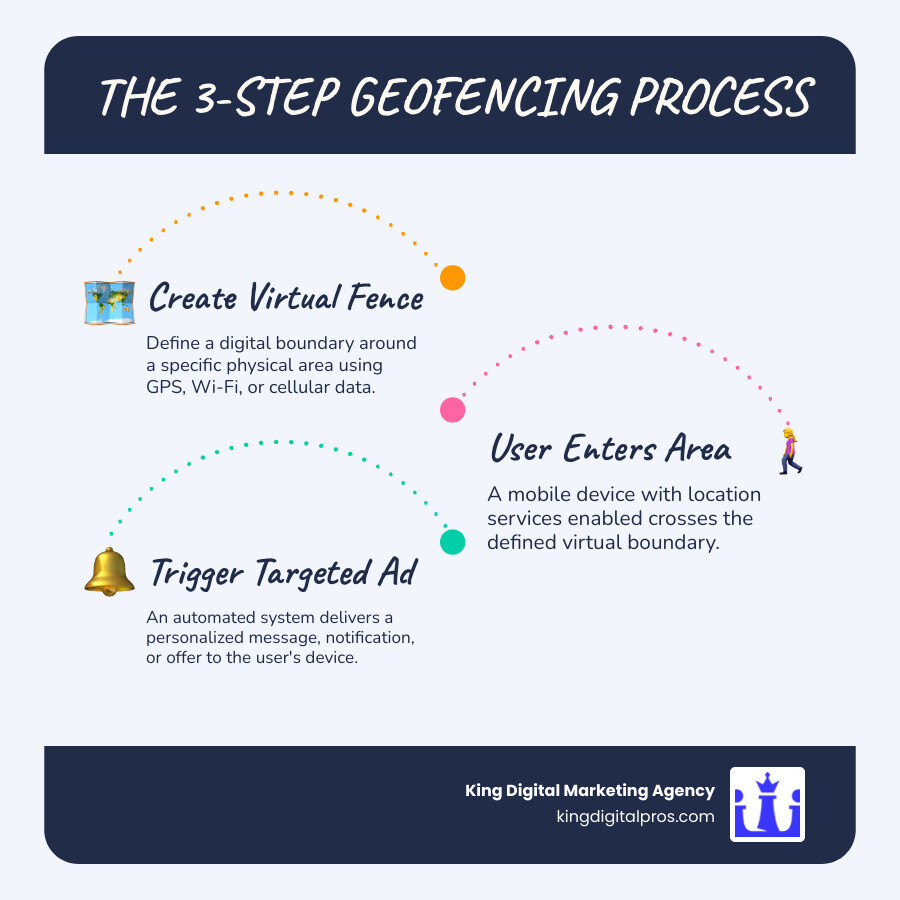
How Does Geofencing Technology Work?
Geofencing works by drawing an invisible line on a digital map. When a location-aware device crosses this line, it triggers a pre-set action, like an ad or notification. This process relies on a combination of technologies:
- GPS (Global Positioning System): The most common method, using satellite signals for high-accuracy location pinpointing.
- Wi-Fi: Uses signals from nearby networks to determine location, especially in urban areas where GPS may be weak.
- Cellular Data: Triangulates a device’s position using cell towers, offering broad coverage with slightly less precision than GPS.
- Radio-frequency identifiers (RFID): Used in specific scenarios like asset tracking. Bluetooth technology, for example, uses radio waves for highly localized marketing within small geofenced areas. You can learn more about how Bluetooth technology works.
Marketers use specialized software with map-like interfaces to draw these geofences. These platforms use APIs (Application Programming Interfaces) to communicate with mobile apps and location services.
A crucial element is user consent. A user’s device must have location services enabled, and they must have granted permission for the relevant app to access their location data. Without permission, the geofence cannot trigger any action.
The Building Blocks of a Geofence
Geofences are strategically shaped to meet marketing objectives. Common shapes include:
- Radius Geofencing: The simplest form, creating a circular perimeter around a central point, like your business. It’s effective for targeting a general area.
- Polygonal Geofencing: Allows for custom shapes that match irregular boundaries, such as a shopping mall or a specific building. This offers greater control over who receives your message. An administrator can use polygonal geofencing software to define a precise boundary.
- Building Footprints: The most granular form, targeting individuals inside a specific store or office. This level of accuracy is invaluable for in-store promotions or competitor conquesting.
The accuracy of a geofence depends on the underlying technology, but modern solutions can be accurate within meters.
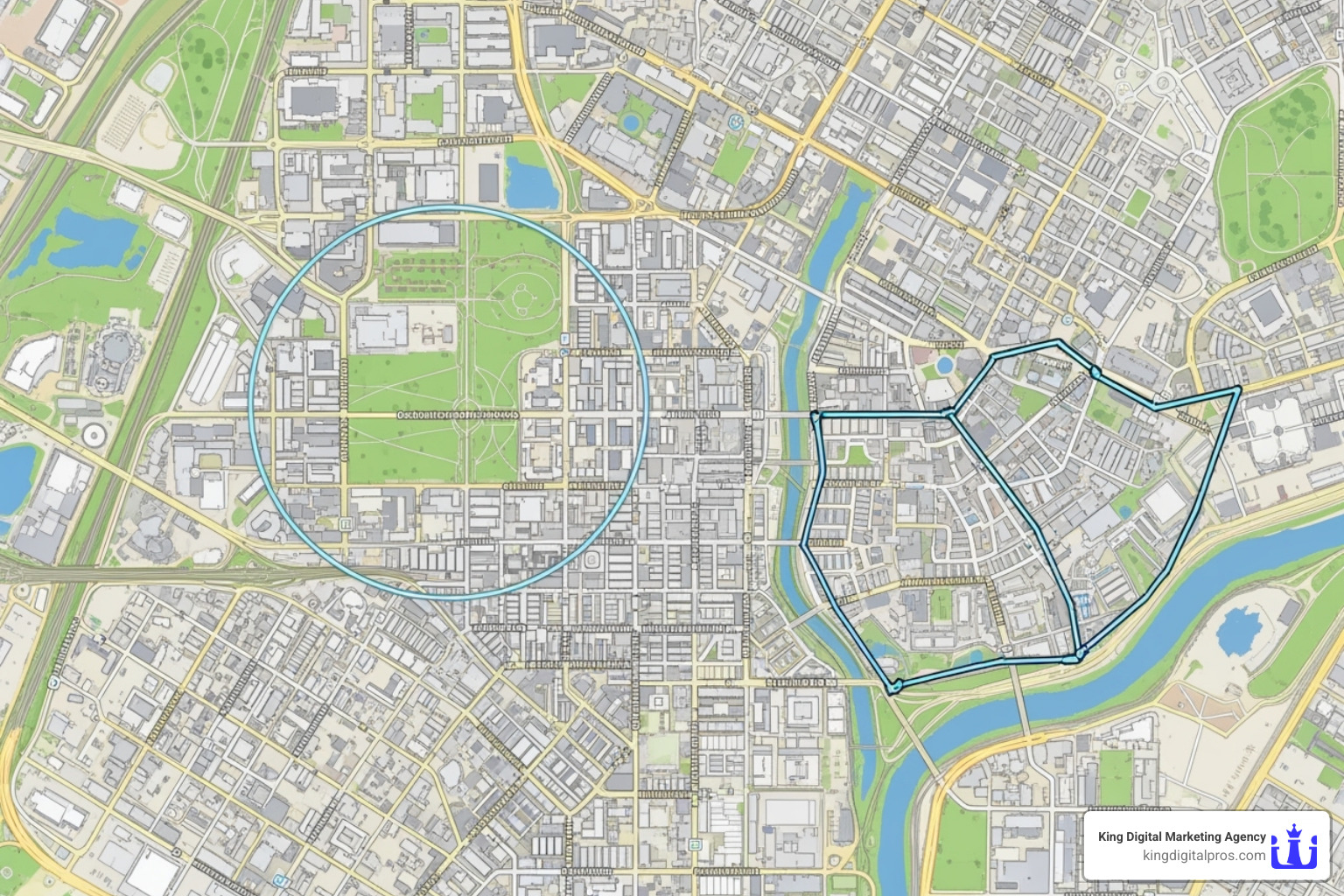
Active vs. Passive Geofencing
Geofencing can be categorized by how it interacts with a user’s device:
- Active Geofencing: Requires the user’s app to be running, using continuous GPS monitoring for real-time alerts. While highly precise, it consumes more battery power. It’s best for immediate interactions, like a flash sale notification upon entering a store.
- Passive Geofencing: Runs in the background using less frequent location checks (often via Wi-Fi or cellular data), making it more battery-friendly. It’s ideal for data collection or for actions that don’t require split-second timing, like sending a follow-up email after a visit.
Choosing the right type involves balancing the need for real-time engagement with user experience and battery life considerations.
The Core Benefits of Geofencing for Local Businesses
Geofencing isn’t just a buzzword; it’s a game-changer for local businesses that delivers measurable results. It offers a powerful way to transform customer outreach.
The most significant benefit is increased foot traffic. Imagine someone walking past your bakery and receiving a message for “15% off fresh croissants.” That’s the power of reaching people when they’re steps from your door. We’re passionate about helping you attract more customers with these innovative approaches.
Other key benefits include:
- Personalized Customer Experience: Instead of generic ads, you can have relevant, timely conversations with potential customers.
- Improved Data Collection: Geofencing campaigns provide valuable intelligence on customer behavior, such as visit duration, peak traffic times, and offer effectiveness.
- Competitive Advantage: While competitors use traditional methods, you can engage customers with surgical precision, leading to higher engagement rates and better ROI.
Hyper-Personalization and Timely Delivery
The magic of geofencing is reaching the right person, at the right time, in the right place. For example, a jewelry store can send a “20% off earrings” notification to someone walking through a shopping center after work. This contextual relevance feels helpful, not intrusive.
The data supports this: over 70% of consumers prefer personalized advertising, and 3 out of 4 take action after receiving a location-based message. This isn’t just engagement – it’s conversion.
This level of personalization also builds customer loyalty. When your marketing adds value rather than interrupting, you earn a relationship, not just a sale. In an era where advertising costs are rising and targeting is becoming more challenging, geofencing offers a refreshingly precise alternative.
Gaining a Competitive Edge
Competitor conquesting (or geo-conquesting) is a powerful strategy for engaging customers who are actively shopping your competition. By setting up a geofence around a rival business, you can send a message highlighting your unique value proposition.
For instance, a restaurant could target people near a competitor with an offer for an award-winning dessert just two blocks away. This tactic simultaneously draws customers from rivals, boosts your brand awareness, and provides valuable market intelligence on competitor foot traffic.
Effective geo-conquesting tactics include:
- Offering a better deal than competitors.
- Highlighting your unique selling points.
- Targeting complementary businesses (e.g., a healthy cafe targeting gym-goers).
- Retargeting people after they leave a competitor’s location.
Understanding the Geofencing Marketing Meaning in Practice
Once a user crosses a geofence, you can reach them through various channels, each with unique advantages for connecting with customers.
- In-App Notifications: If users have your app, you can send immediate, personal push notifications to drive foot traffic, like an offer for fresh-baked goods as they walk by.
- Targeted Display Ads: Customized ads can appear on websites and apps that users browse while inside your geofenced area, making them highly relevant.
- SMS Marketing: For customers who have opted in, you can send personalized offers or reminders via text message when they enter your target zone.
- Social Media Ads: Ads can appear in users’ social feeds on platforms like Facebook and Instagram when they are within your defined area, blending seamlessly with their browsing.
- Email Triggers: A less immediate but valuable touchpoint, you can send automated emails like “Welcome to the neighborhood” or “Thanks for visiting” to build lasting relationships.
Our Geofencing Marketing Services can help you determine the right channel mix for your business goals.

Different Types of Geofencing Marketing Strategies
Geofencing’s flexibility allows for customized campaigns to achieve various business objectives.
- Targeting Competitor Locations: Present compelling offers to customers at rival businesses, reaching them when they’re ready to buy.
- Targeting Event Venues: Capture concentrated audiences near stadiums, convention centers, or concert halls with timely offers.
- Targeting Complementary Businesses: Reach relevant audiences by geofencing related businesses, like a coffee shop targeting customers near a bookstore.
- Retargeting Past Visitors: Build loyalty by tracking repeat customers at your location and delivering personalized offers.
- Promoting Loyalty Programs: Remind existing customers of their points or exclusive discounts when they approach your business.
- Audience Segmentation: Combine location with demographic data to target specific groups, like young professionals near an office building during happy hour.
Real-World Examples of Successful Campaigns
Major brands have used geofencing to achieve remarkable results, demonstrating its creative potential.
- Burger King’s Whopper Detour: Geofenced McDonald’s locations to offer a 1-cent Whopper through their app. The viral campaign, as noted by Marketing Land, drove over 1.5 million downloads and sent the app to #1 in its category.
- Sephora’s Companion App: The app activates when a customer enters a store, providing access to purchase history, recommendations, and promotions, bridging the digital and physical shopping experience.
- Whole Foods: Used geo-conquesting by fencing competitor grocery stores to capture customers already in a shopping mindset, leading to high conversion rates.
- Starbucks: Sends push notifications with seasonal offers and personalized recommendations when customers are near an outlet, creating timely “coffee moments.”
- Automotive Dealership: A luxury dealer geofenced competitor locations and attracted 500 new prospects to their website and 132 potential customers to their showroom in 30 days.
- HotelTonight: The app sends “Rate Drop” notifications for discounted same-day bookings when users are near participating hotels after 3 p.m., creating urgency and convenience.
Successful campaigns are timely, relevant, and provide genuine value at the moment of interaction.
Geofencing vs. Geotargeting: What’s the Difference?
While related, geofencing and geotargeting are distinct location-based marketing strategies. Understanding the difference is key to a successful campaign.
Geofencing creates a virtual boundary and triggers an immediate, action-based response (like a push notification) when someone crosses it. It’s about real-time presence.
Geotargeting is broader, delivering ads to people based on their general location (like a city or zip code) combined with other criteria like demographics or interests. It’s about audience characteristics within an area.
| Feature | Geofencing | Geotargeting |
|---|---|---|
| Definition | Setting a virtual boundary that triggers an action when entered/exited. | Delivering ads to users based on their broader geographic location. |
| Precision | Hyper-local (down to a building or street). | Broader (country, state, city, zip code, radius around a general point). |
| Trigger | Action-based: Triggered by physical entry/exit from a defined area. | Audience-based: Ads displayed based on user’s general location & other criteria. |
| Target Audience | “Anyone who enters this virtual boundary.” | “Specific people in this area who meet certain demographic/behavioral criteria.” |
| Technology Focus | GPS, Wi-Fi, Cellular Data, RFID (real-time location detection). | IP address, device location settings, user-declared location (broader targeting). |
| Use Case Example | Sending a coupon when someone walks into your store. | Showing ads for your store to everyone living in a certain zip code. |
| Granularity | More granular, focused on real-time physical presence. | Less granular, focused on general geographic relevance and audience layering. |
The key difference is precision and the trigger. Geofencing responds to real-time physical presence, while geotargeting relies on broader location patterns and user data.
For example, a coffee shop using geotargeting might show ads to all coffee lovers within a 5-mile radius. With geofencing, it would send a “Buy one, get one free” notification only to people who walk past its storefront.
Both strategies are valuable. Geofencing excels at driving immediate action, while geotargeting is better for building broad brand awareness.
Launching & Measuring Your Geofencing Campaign
Launching a successful geofencing campaign requires clear goals, a defined budget, compelling ad creative, and a commitment to privacy.
First, define your campaign goals. Are you trying to drive foot traffic, gather competitor data, or boost product awareness? Your goal will guide every decision.
Next, establish your budget. Geofencing is cost-effective because it focuses your spend on likely customers. Most campaigns use a Cost Per Thousand Impressions (CPM) model.
Your ad creative must grab attention and provide a clear Call to Action (CTA). A short, punchy message with an irresistible offer can convert a passerby into a customer.
Finally, ensure privacy compliance. Adhering to regulations like GDPR and CCPA by securing user consent and providing opt-out options builds trust. This aligns with our approach to Sales Lead Management, where customer privacy is paramount.
Best Practices for an Effective Strategy
Follow these best practices to create a geofencing campaign that delivers results:
- Define the right geofence size: A four-to-five minute travel radius is a good starting point. Too large wastes money; too small misses opportunities.
- Set a clear objective: A vague goal like “increase brand awareness” leads to fuzzy results. A specific goal, like promoting a lunch special, is more effective.
- Create compelling, relevant content: Your message should reflect your customer’s physical and mental context, offering immediate value.
- Manage timing and ad frequency: Promote offers at relevant times (e.g., a lunch special at 11:30 AM). Aim for about 10 impressions per user per month to stay top-of-mind without being annoying.
- A/B test locations and messaging: Continuously test different offers and locations to find what resonates best with your audience.
How to Track Success and Measure ROI
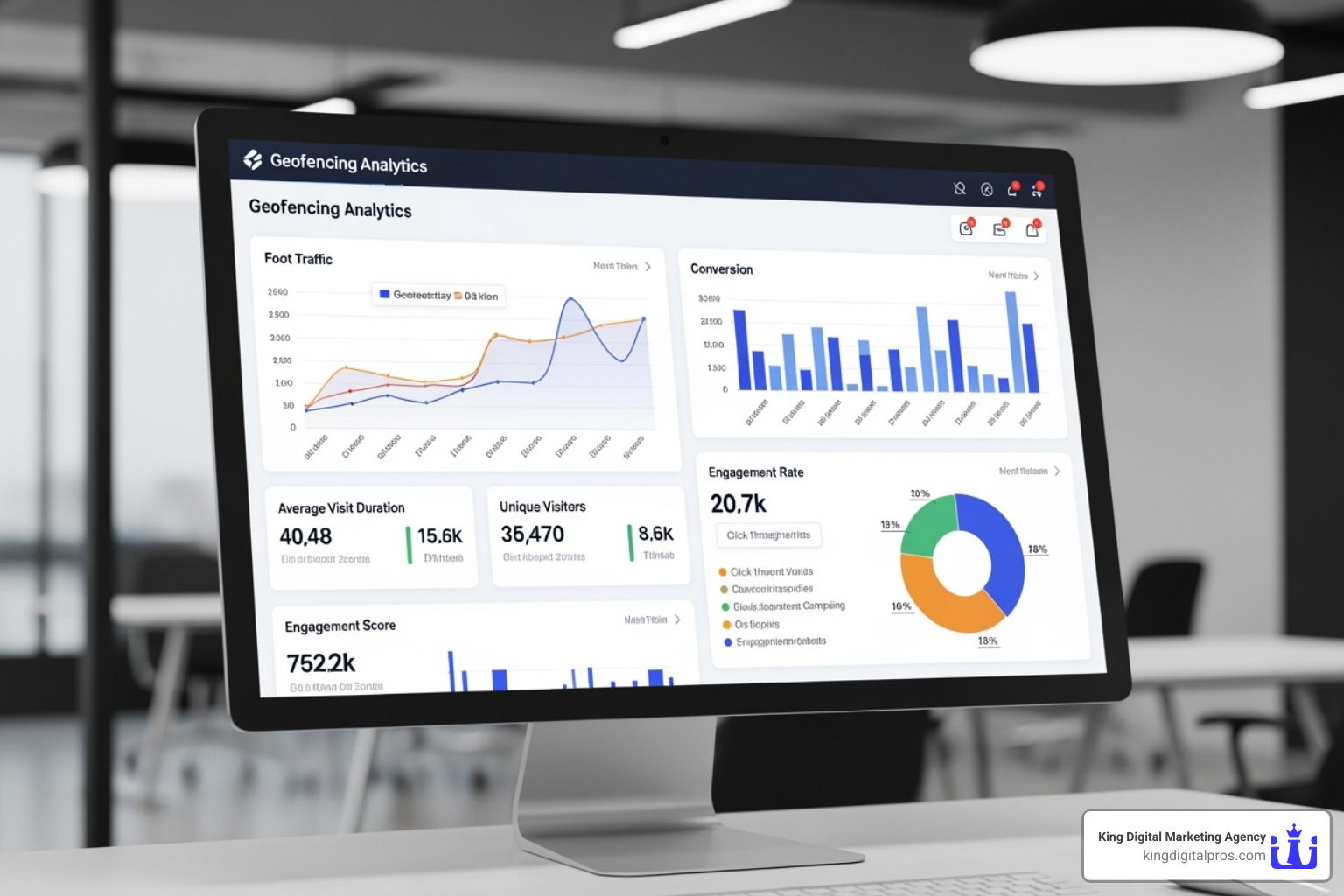
Track these key metrics to measure your campaign’s success and ROI:
- Foot Traffic Attribution: The gold standard. It tracks how many people who saw your ad actually visited your location, directly linking digital spend to real-world results.
- Click-Through Rate (CTR): Shows how compelling your message is. A high CTR means your offer is resonating.
- Conversion Rate: Measures what happens after the click – did the user make a purchase, sign up, or call?
- Cost Per Acquisition (CPA): Calculates how much you spend to gain each new customer. CPA is typically lower with geofencing due to its precise targeting.
- Return on Ad Spend (ROAS): The ultimate scorecard, showing the revenue generated for every dollar spent.
Our Tools & Marketing ROI Calculator can help you project these returns before you invest.
What Are the Potential Costs?
Geofencing is often more cost-effective than traditional ads because of its precision. Most campaigns use a Cost Per Thousand Impressions (CPM) pricing model, with average CPMs ranging from $4 to $14.
Costs are influenced by several factors:
- Geofence Size and Precision: Targeting a specific building footprint is more expensive per impression but often yields better results than targeting a general neighborhood.
- Data Layering: Adding demographic or behavioral targeting increases costs but also boosts relevance.
- Campaign Scale: Larger campaigns may have higher total costs but can benefit from volume discounts.
- Platform Fees: Costs vary between basic platforms (like Google Ads) and advanced, specialized geofencing providers.
- Bidding Strategy: High-competition areas or popular audiences can drive up prices.
The precision of geofencing ensures your budget works harder, delivering stronger returns by focusing only on potential customers.
Conclusion
We’ve explored the geofencing marketing meaning, from its underlying technology to its practical application. It’s clear that this strategy is an essential tool for local businesses.
Geofencing creates meaningful connections by reaching customers at the perfect moment – when they are nearby and ready to buy. Whether someone is walking past your shop or browsing a competitor’s showroom, geofencing inserts your business into their decision-making process.
This technology levels the playing field, allowing small local businesses to compete with larger chains by being smarter about customer engagement. A 20% boost in foot traffic isn’t just a statistic; it’s real people walking through your doors.
At King Digital Marketing Agency, we’ve seen how powerful location-based marketing is when combined with strong local visibility. Optimizing your Google Business Profile creates the foundation, and geofencing adds the active outreach that turns browsers into buyers.
The future of local marketing is about being present at the right moment. Businesses that adopt geofencing now will gain a significant advantage. Think of it as a digital sales team working 24/7 to grow your business while you focus on serving your customers.
Ready to transform how your business connects with local customers? We’re excited to show you what’s possible. Learn more about our Geofencing Marketing services and find out how we can help your business thrive.
